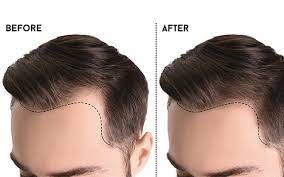
Ingrown Hair: Causes, Stages, Diagnosis & Best Treatment
Hair loss is a type of hair loss, also known as widow's peak. Genetic factors, along with aging, lead to baldness. Frontal hair loss usually occurs in men around the age of 20.
It is important to understand that a certain level of shedding is quite average; Most people lose 50 to 100 hairs in a day. However, there are always ways to prevent bald patches. Understand when you should go for Hair transplant in delhi
Why does the male hairline recede?
Bald patches usually occur in men due to specific hormones called "androgens" and "testosterone". Androgens and testosterone also play an important role in bald patches.
Male pattern baldness, also known by the medical term "androgenetic alopecia", is primarily caused by the shrinking of hair follicles and thus the thinning of hair, which eventually leads to hair loss. And worse, there is baldness.
Men are more likely to have oily skin, which leads to dandruff and can lead to thinning hair or baldness over time. If you have oily skin then the pores can get clogged.
Oily skin attracts more dirt, so it can clog hair follicles. When hair follicles become clogged, they can hinder the natural growth of hair and lead to baldness.
What causes a woman's hair to stand out?
Bald spots also cause lack of confidence in some women. Bald patches can be due to many reasons. These include infectious diseases, excessive hair processing, hair pulling, alopecia areata, autoimmune diseases, thyroid disease, ovarian tumors, adrenal tumors, and burns.
Genetics also play a role in female hair loss. Women between the ages of 30 and 60 may also experience severe hair loss or thinning.
Stages of child residence
Stage I:
This pattern baldness refers to minimal hair loss. The hair still appears thicker and hair loss usually goes unnoticed. This type can be considered "normal" for a person in their late teens and early 20s. If you are in the first phase at age 30, you may be in luck.
Phase II:
This stage indicates that hair loss has begun around the temples, but it may be too light to be noticeable. Mostly it happens suddenly. Especially when a man is in his early 20s and in the last wave of puberty. It can also be a cause of worry for a youngster, but it should not mean that he is bound to go bald.
Stage III
This is the stage where hair loss becomes noticeable as deep temporary recession can be observed. When a man is 40 years old, it may be "normal". Most men lose hair to some degree as they age. It is also the first stage in which treatment becomes feasible.
Stage IV
Shows continuous hair loss around the hairline with thinning more noticeable on the top of the head. When trying to slow progression, you may want to start treatment here, and a Hair transplant Surgeon in Delhi may be an option.
Stage v
It represents large areas of hair loss in the front and top of the head. However, at this stage, there is still hair left in the middle of the scalp.
Sixth stage
At this stage, hair loss is significant. At this time, most of the hair on the top of the head falls out. There may be finer hair between the bald spots and on the top of the head. Generally though, it is a continuous area of hair loss.
Some people call this pattern a "horseshoe" because the rest of the hair forms a "U" shape on the sides and back of the scalp. To restore such an image will require several implant sessions. Apart from this, it also depends on the availability of donors, which are usually not so many at this stage.
Stage VII
This more extreme condition means that there is literally no hair on the front and top of the head. The rest of the hair is above the ears and also on the back of the head.
